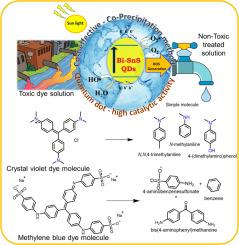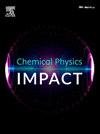双掺杂SnS量子点光催化降解及通过种子萌发评价处理后废水的植物毒性
IF 4.3
Q2 CHEMISTRY, PHYSICAL
引用次数: 0
摘要
量子点(QDs)由于其独特的光学特性,如高吸收系数和可调带隙,可实现有效的可见光吸收和电荷载流子的产生,因此被用于光催化应用。本文主要研究了用于环境修复的均相铋掺杂硫化锡量子点的合成。通过简单、经济的化学方法制备了不同Bi浓度的双掺杂SnS量子点,并通过x射线衍射(XRD)、紫外可见光谱(UV-Vis)和透射电子显微镜(TEM)分析了其结构、光学和形态特征。TEM结果证实了催化剂的均匀性和微小性(< 5nm)。光催化活性是通过暴露在可见光下晶体紫(CV)和亚甲基蓝(MB)的分解来评估的。CV和MB的效率分别为89.0%和95.8%,优于未掺杂的SnS。动力学分析揭示了一个伪一级反应,为潜在的降解动力学提供了见解。提出了一种合理的机制,阐明了双离子掺杂如何提高光催化性能并促进染料降解。此外,利用辐射维纳种子进行的毒性评价表明了降解过程的有效性。处理过的染料溶液(D-CV和D-MB)与未处理的染料和对照溶液相比,细胞内ROS水平没有显著变化,证实毒性降低。这些发现突出了双掺杂SnS量子点的增强光催化性能及其在环境净化方面的潜力,促进了对基于量子点的光催化剂的可持续应用的理解。本文章由计算机程序翻译,如有差异,请以英文原文为准。

Photocatalytic degradation using Bi-doped SnS Quantum dots and phytotoxicity evaluation of treated effluents through seed germination
Quantum dots (QDs) are employed in photocatalytic applications because of their distinctive optical characteristics, such as high absorption coefficients and tunable bandgaps, enabling efficient visible light absorption and charge carrier generation. This study focuses on synthesizing homogeneous bismuth-doped tin sulfide (Bi-doped SnS) QDs for environmental remediation. Bi-doped SnS QDs with varying Bi concentrations are prepared via a facile, cost-effective chemical method, and their structural, optical, and morphological characteristics are analyzed through X-ray diffraction (XRD), UV–Vis spectroscopy, and transmission electron microscopy (TEM). TEM results confirm that the catalysts are highly homogeneous and tiny (<5 nm). Photocatalytic activity is assessed through the breakdown of Crystal Violet (CV) and Methylene Blue (MB) when exposed to visible light. High efficiencies of 89.0 % and 95.8 % are achieved for CV and MB, respectively, outperforming undoped SnS. Kinetic analysis reveals a pseudo-first-order reaction, providing insights into the underlying degradation kinetics. A plausible mechanism is proposed, elucidating how Bi-ion doping enhances photocatalytic performance and facilitates dye degradation. Additionally, toxicity evaluation using Vigna radiata seeds demonstrates the efficacy of the degradation process. Treated dye solutions (D-CV and D-MB) show no significant changes in intracellular ROS levels compared to untreated dye and control solutions, confirming reduced toxicity. These findings highlight the enhanced photocatalytic performance of Bi-doped SnS QDs and their potential in environmental purification, advancing the understanding of QD-based photocatalysts for sustainable applications.
求助全文
通过发布文献求助,成功后即可免费获取论文全文。
去求助
来源期刊

Chemical Physics Impact
Materials Science-Materials Science (miscellaneous)
CiteScore
2.60
自引率
0.00%
发文量
65
审稿时长
46 days
 求助内容:
求助内容: 应助结果提醒方式:
应助结果提醒方式:


